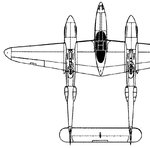- Thread starter
- #21
Another single-country, simple design could've been non-turboed P-38, like one French ordered from Lockheed (later tested by RAF and discarded).
The most conservative max speed figure I've found was 357mph (clean, of course; C series of V-1710); the highest figure was 400mph (very doubtful). Very problematic catch for Zeroes Oscars, even with 360 mph. The space weight of turbo accessories can be used for extra fuel tanks, while cutting down the armament to 3 .50cals enables more pilot armor to be added.
With 1300 HP Allisons from early 1943 on, it takes Hayate to intercept it
In same time, 4 instead of 2 inner pylons, please.
The most conservative max speed figure I've found was 357mph (clean, of course; C series of V-1710); the highest figure was 400mph (very doubtful). Very problematic catch for Zeroes Oscars, even with 360 mph. The space weight of turbo accessories can be used for extra fuel tanks, while cutting down the armament to 3 .50cals enables more pilot armor to be added.
With 1300 HP Allisons from early 1943 on, it takes Hayate to intercept it
In same time, 4 instead of 2 inner pylons, please.

